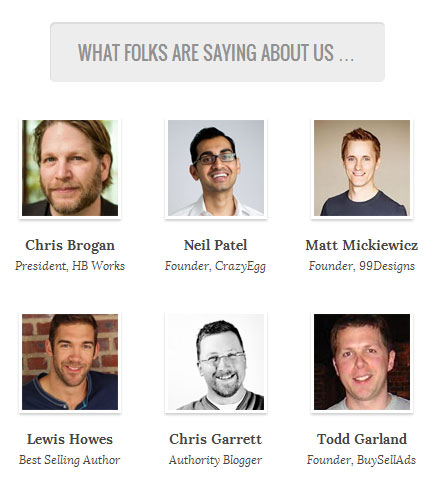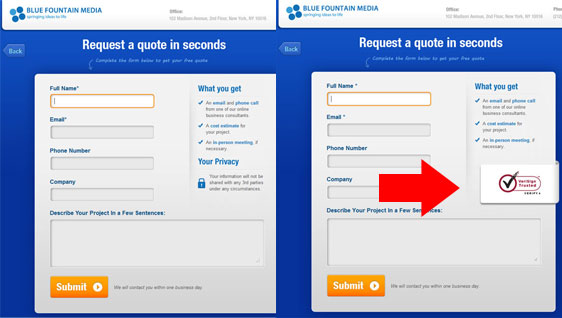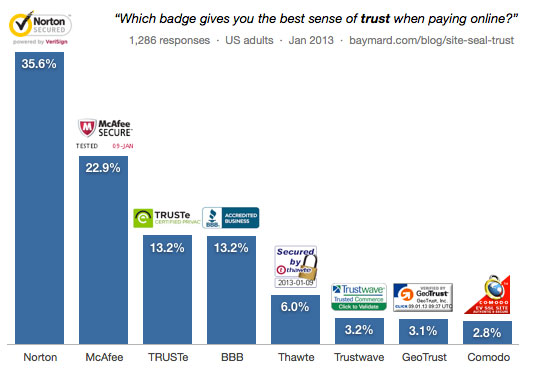Did you know that 63 percent of customers are more likely to make a purchase from a site that has user reviews? Or that a simple security seal can increase your sales by 42 percent? It shouldn’t come as a surprise — trust is by far the most important factor in a person’s purchase decision. A Harvard Business School study showed that a one-star increase in rating leads to 5-9 percent increase in revenue.
Imagine if I told you that I’m the best Internet marketer on the planet. I can help drive sales by bringing new visitors to your website, converting them into subscribers or customers and boost your overall revenue. You probably wouldn’t believe me. Or worse, you’d think that I’m full of myself.
But what if someone else told you the same thing about me? You would probably want to check out my work. That’s an example of social proof. It’s powerful because it triggers emotion. People relate to others. They relate to their friends. They relate to celebrities and experts. Most importantly, they relate to things that help them feel confident about their decisions.
Let’s take a look at eight clever ways to leverage social proof with examples that you can add to your site to boost sales and conversions.
Customer Testimonials
Testimonials are by far the easiest form of social proof you can add to your site. We all think that our product and service is great, but people may not believe you unless they hear it from other people too. That’s why you should reach out to your happiest customers and ask them for a short testimonial to post on your website.
Look through your customer support tickets or recent praises on Twitter. Next, ask those folks if you can make their responses a testimonial for your site. If you have a brand new product or service, invite influencers, journalists, and/or your typical user, and give them a free copy in exchange for an honest review. Because testimonials can be easily faked, you should include a customer’s photo, name, company and job title to boost their credibility.
You can take it one step further and actually embed the actual tweet on your site:
Can you guess when we added @optinmonster to our mix for email subscriptions? pic.twitter.com/mJr2cmVtLv
— Wes Linda (@WesLinda) July 22, 2014
Media and Mentions
One of the best ways to boost your credibility is by borrowing someone else’s. That’s why you’ll see a lot of websites showing “featured in” or “mentioned with” alongside logos of top media outlets or well-known brands. Most people think it’s really hard to get featured in these top publications, so they don’t try. Those who do try and are persistent get featured. Here are few tricks that can help:
Guest blog: Most sites welcome guest contributors as long as you have something valuable to add for their readers. Remember, this article isn’t to pitch your product. The fact that they are giving you an author byline, backlink (SEO) and exposure is more than enough.
Quotes/Roundups: Quotes and roundups are becoming popular because they’re frequently shared. Find the author of a roundup you want to be included in and get in touch. Here’s a simple email template to use:
Hey {First Name},
I really liked the article that you published on {Publication Name} about {Modified Article Title}.
I found it really helpful. I’m trying {Insert Tip from the Article}, and it’s making a huge difference. I just wanted to send you a thank you note.
I’m sure you get tons of emails, but I would love to get a reply so I know that you got my message.
Already followed you on Twitter so I can stay updated with your newest articles.
Best,
{Your Name}
Remember, you are going for a long-term relationship vs. a one-time sell. Genuinely interact with them on social media. Alternatively, you can prepare a similar round up and reach out to several well-known experts. Once you have their tips, you can pitch it to the top publication. Because you are borrowing the credibility of these experts and you did all the hard work, at least one of the publications will publish your article.
Traditional PR: You can also go the traditional PR route. Create a story and pitch it to each publication. Start small and work your way up. When you are adding these mentions, please make sure you are being smart about it.
Stay away from phrases like these:
- “Our clients have been mentioned in….” This is acceptable if you are a PR agency because that’s how you showcase your work. However, if you are a freelance web designer who got a contract for Zillow, and you add logos for every media outlet that mentions Zillow, that’s a bit crazy.
- “Our speakers have been mentioned in….” This is something I have seen at smaller conferences and some podcast landing pages. If you are displaying 15 media outlet logos right below your call to action, I find it a bit deceiving.
You should still showcase the accomplishments of your speakers, but that’s what bylines and bio pages are for.
Celebrity/Authority Endorsements
People trust celebrities and experts. Having their endorsement can really help your sales. This is my No. 1 tip: I recommend getting industry experts to give you testimonials.

You can also pay celebrities for endorsements. Priceline used a celebrity endorser back in 1997. William Shatner agreed to take company shares as part of his payment. Over the years, his shares in Priceline are estimated to be worth over $600 million.
Co-Hosted Webinars or Interviews
Another great way to add social proof is by associating yourself with well-known brands and experts by co-hosting webinars or conducting interviews. Find companies that are well-respected within your industry and have the same type of customers. Reach out to them and come up with a strategy that benefits both parties. Co-hosted webinars are a great way for cross-promotion, so it’s not a strategy that you can use when you are just starting out, as you don’t have much to give back.
Interviews, on the other hand, are simple. Invite experts to share their thoughts on your blog. You can do this via a podcast, text interview, video interview or even on a Twitter chat. I really love the #BufferChat concept. The team at Buffer invites one expert a week to their Twitter chat. This is great value for Buffer, the expert hosting the chat and the audience.
Case Studies
When people are deciding whether to purchase, nothing helps them more than knowing that the product works. Testimonials are great, but you can go deeper. Have detailed case-studies of your customers. KissMetrics does a great job of highlighting their customers with case studies.
Number of Shares/Followers
Probably the easiest way to add social proof is by showing the number of shares your blog posts and articles have received. The hard part is actually getting these shares. So here are few tricks to boost your numbers:
Combine the Total Count: I first saw this on Mashable and then TheNextWeb. It makes sense. You may get a lot of shares on one network while very little on others. Showing a total count solves that problem and make your article look more popular. I added them on my site List25, and the share counts went up.
Eventually I’ll have the List25 widget added on all sites. We made ours custom, but there are several plugins that have this functionality. One of them is called Mashshare.
Paid promotion: When your site is new, set aside a daily promotion budget for your articles. Facebook is the best one that I’ve found because it’s so cheap. Simply use the boost post feature — it also helps the like-count on your site. The GetNoticed theme I use comes with a widget that combines my follower count from all different platforms.
Important Statistics
Numbers convert better. Whether that is the number of total downloads of your software or total customers, metrics are important for conversions. Akismet, an anti-spam service, shows exactly how much spam they block. Basecamp displays the number of companies that signed up just last week.
Trust Seals
Believe it or not, adding trust seals on your checkout page can really boost your sales because they help your credibility. The folks at Blue Fountain Media did a split-test. The only thing they added was a Versign trust seal, and they saw an increase of 42 percent in sales.

If you are wondering which seal you should add, take a look at the study conducted by Baymard Institute. It shows which seal customers trust more.

Sources: iPerceptions, 2011 / Baymard Institute 2013 / Blue Fountain Media / Harvard Business School, 2011
A version of this post originally appeared here.













